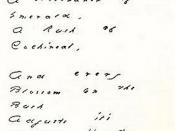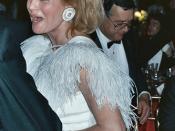Emily Dickinson's poetry can be seen as a study of deep fears and emotions, specifically in her exploration of death. In her famous poem #465 Dickinson explores the possibility of a life without the elaborate, finished ending that her religious upbringing promised her. She forces herself to question whether there is a possibility of death being a mundane nothingness. In this last moment of doubt in the appearance of the divine, the speaker in the poem find an independent and personal acceptance of a death without profundity or salvation.
The speaker of the poem is dying, and it is possible to infer that her journey toward death has been a longer one. The family and friends surrounding her in the room because "the eyes beside had wrung them dry, and breaths were gathering sure." The people in the room have cried all there tears, and are confidant that their friend or family member (the speaker) is going to a better place.
However, the narrator does not share with them this feeling of calm and assurance, as she waits for the "King" or godlike figure to be witnessed near her deathbed, the mundane presence of a fly buzzing in the room makes her doubt the sanctity and religious significance of her experience.
The fly and the king become polarized images. The fly, representing the mundane, is keeping the speaker firmly on earth, preventing the epiphany that some sort of holy or religious appearance (the King, for instance) would bring. Other polarized images presented in this first stanza are the stillness of air between the heaves of storms. The speaker was assuming the stillness around her on her death bed meant that she was waiting for some sort of major upheaval, some sort of religious moment when she would be whisked from...


